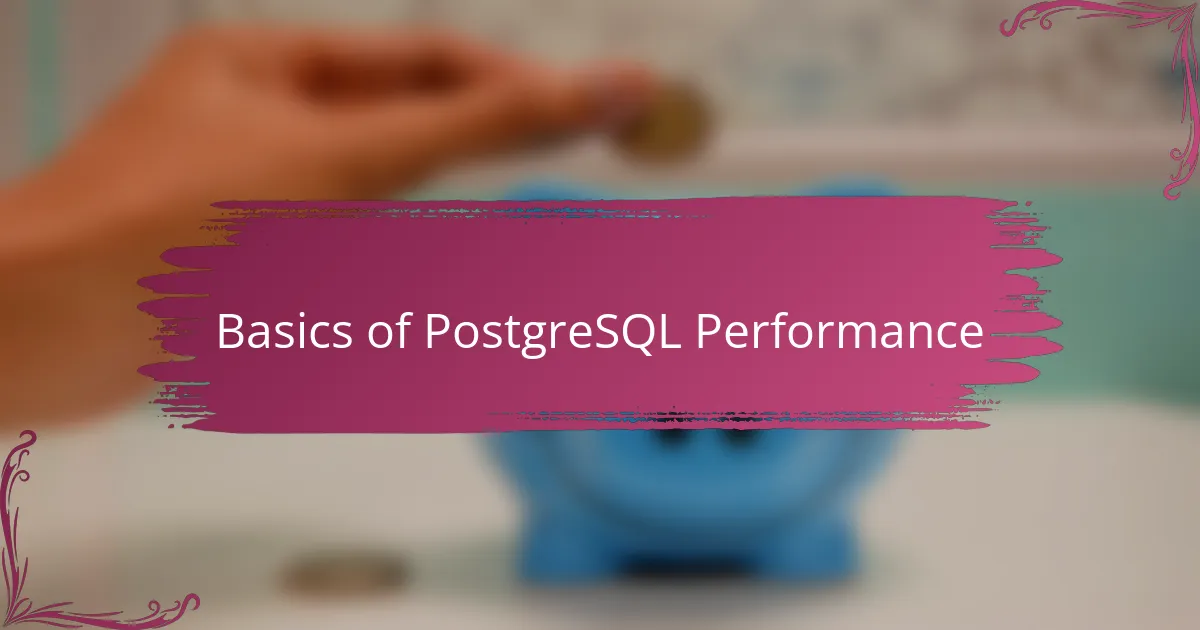Key takeaways
- Understanding execution plans in PostgreSQL is essential for efficient query optimization.
- Keeping database statistics up-to-date and using proper indexing strategies can significantly enhance performance.
- Breaking down complex queries and conducting incremental testing promote clarity and consistent improvement.
- Regularly reviewing execution plans and maintaining index hygiene helps prevent performance issues over time.

Understanding SQL Query Optimization
When I first started optimizing SQL queries in PostgreSQL, I quickly realized that understanding how the database executes a query is crucial. It’s not just about writing code that works; it’s about writing code that works efficiently. Have you ever waited impatiently for a report to generate and wondered why it took so long? That frustration pushed me to dive deeper into query optimization.
At its core, SQL query optimization is about helping PostgreSQL choose the best path to retrieve data. The database uses something called an execution plan—a step-by-step strategy to get your results. From my experience, reviewing these plans can feel like peering under the hood of a complex machine; sometimes it’s straightforward, other times it’s a puzzle.
What I find fascinating is how small changes in a query—like tweaking a join or an index—can drastically alter performance. It’s like tuning a musical instrument: the right adjustment brings harmony, while the wrong one creates discord. Understanding this interplay has not only improved my skills but also deepened my appreciation for PostgreSQL’s intelligence.

Basics of PostgreSQL Performance
Performance in PostgreSQL starts with knowing what resources your queries use. I remember early on being surprised at how much difference a well-placed index made. It was like turning a sluggish old car into a sleek sports model—suddenly, everything ran smoother and faster.
One key aspect that struck me is how PostgreSQL uses statistics about the data to decide on query plans. Have you ever tweaked your database only to see no improvement? Chances are, the planner didn’t have up-to-date information, which made it guess wrong. Keeping those statistics fresh became a game-changer for me.
Another thing I’ve learned is the impact of configuration settings on basic performance. For example, adjusting work memory or enabling parallel queries can unlock significant speed gains. It’s a bit like adjusting your workspace lighting—small changes, but they make a big difference in how easily you can get things done.

Common Bottlenecks in Queries
One of the most common bottlenecks I’ve encountered is inefficient joins. Have you ever noticed how adding just one poorly chosen join can cause your query to drag? It’s like inviting too many guests to a small room—everything slows down as they jostle for space.
Another culprit that kept tripping me up was missing or misused indexes. Early on, I underestimated the impact of indexes and ended up scanning entire tables instead of quickly jumping to the data I needed. That experience taught me that even the best-written query can crawl without proper indexing.
And then there’s the issue of data volume and filtering. I’ve seen queries choke when handling huge datasets without narrowing down results early. It made me realize how vital it is to push filters as close to the source as possible—otherwise, the database wastes precious time processing unnecessary rows.

Techniques for Query Improvement
When I started experimenting with query improvement techniques in PostgreSQL, one thing that really stuck with me was the power of rewriting queries. Have you ever tried breaking a complicated query into smaller parts? From my experience, decomposing complex joins or subqueries often makes PostgreSQL’s planner work smarter, not harder.
Another technique I lean on is proper indexing strategy. It took me a while to realize that not all indexes are created equal—sometimes a multi-column index or a partial index can be a game-changer. Have you ever been baffled why an index didn’t speed up your query until you matched it perfectly to your WHERE clauses? That insight transformed how I approach indexing.
Lastly, I can’t stress enough the value of analyzing and updating statistics regularly. Early on, I ignored this step and watched my queries run sluggishly despite all other optimizations. PostgreSQL relies heavily on these stats for decision-making, so keeping them fresh is like giving the planner its GPS fixed—suddenly, it knows the best routes.

Tools for Analyzing PostgreSQL Queries
One of the first tools I found indispensable for analyzing PostgreSQL queries is EXPLAIN. Just running EXPLAIN on a query feels like getting a backstage pass—it reveals the execution plan and shows how PostgreSQL intends to fetch your data. At times, interpreting this output can be a bit overwhelming, but I learned that patience pays off as it uncovers hidden inefficiencies.
Another tool that changed my approach is EXPLAIN ANALYZE, which not only shows the plan but also runs the query and reports actual run times. Seeing the difference between the estimated and actual costs opened my eyes to how the planner can sometimes misjudge. Have you ever spotted a surprising delay after EXPLAIN ANALYZE? That’s often where the real performance battles hide.
For more visual thinkers like me, third-party tools such as pgAdmin and QueryPlanVisualizer have been game-changers. They transform raw plan data into colorful graphs that make spotting bottlenecks more intuitive. When I started using these, understanding complex, nested operations became less daunting and even, dare I say, enjoyable.

Personal Strategies for Optimization
When it comes to personal strategies for optimizing SQL queries in PostgreSQL, I find that patience and curiosity go a long way. I often start by isolating slow parts of a query—breaking it down piece by piece helps me identify exactly where performance tanks. Have you ever felt overwhelmed by a massive query? Splitting it up made things clearer for me, almost like taking a complex puzzle apart before putting it together again.
Another strategy that really became a habit is constantly revisiting and refining my indexes. Early on, I thought creating an index once was enough. But over time, I learned that evolving data patterns demand evolving indexes. It’s a bit like tuning an instrument regularly instead of once and assuming it will stay perfect forever.
Finally, I rely heavily on incremental testing. Instead of rewriting an entire query at once, I tweak one thing, check its impact, and build from there. This approach keeps me from chasing too many changes blindly and prevents frustration. Isn’t it more satisfying to see steady improvement rather than hoping for a magic fix? For me, this steady, measured approach transformed my optimization efforts from guesswork into a thoughtful process.

Tips for Maintaining Efficient Queries
Keeping your queries efficient over time is really about vigilance. For me, regularly reviewing execution plans—even when things seem fine—has prevented performance surprises down the road. Have you ever felt caught off guard by a sudden slowdown? That’s often when a quick check of your query stats and indexes can save the day.
One habit that’s worked wonders is maintaining up-to-date statistics with commands like ANALYZE. I remember ignoring this step early on and wondering why my tweaks had no effect. Updating stats felt like giving PostgreSQL a clearer map, and suddenly, query plans made much more sense. It’s a small task, but trust me—it pays big dividends.
Don’t forget about indexing hygiene, either. Over time, unused or redundant indexes can clutter your database and slow things down. I’ve had moments where cleaning up indexes was like decluttering a messy desk: it brought order and speed back to my workflows. Have you checked recently which indexes truly pull their weight?